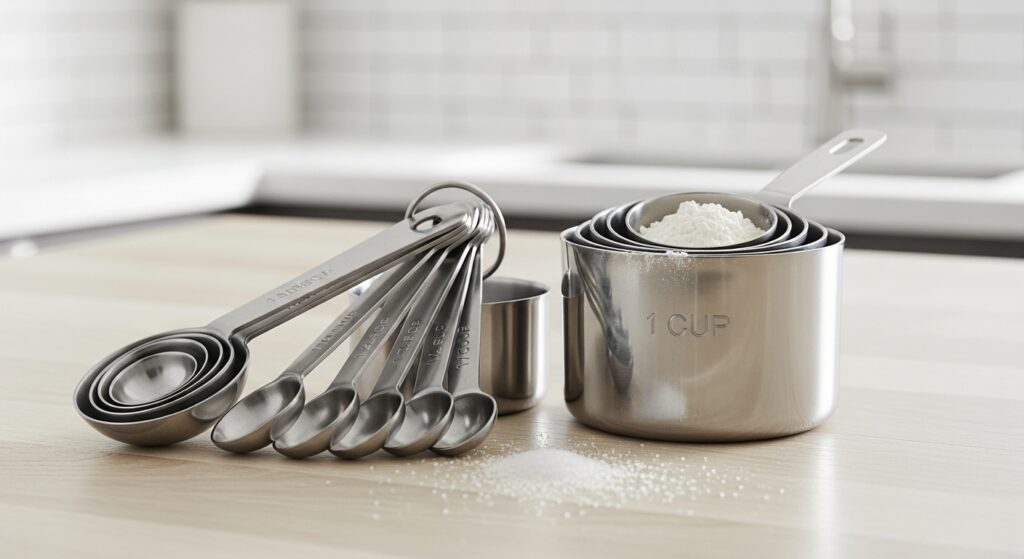In cooking and baking, precision is the secret ingredient that transforms a good recipe into a great one. Whether you’re a seasoned chef or a home cook exploring new flavors, knowing how to measure ingredients accurately can make all the difference. One common question that arises in the kitchen is: how do you convert 9 tablespoons to cups?
While it might sound simple, understanding conversions like this one not only improves consistency but also helps you scale recipes, reduce waste, and gain confidence in your culinary skills. This article explores the exact conversion of 9 tablespoons to cups, provides practical cooking tips, and explains why mastering measurement conversions is essential for anyone who loves to cook.
Understanding the Basics of Kitchen Measurements
Before diving into the conversion itself, it’s helpful to understand how the tablespoon and cup relate to each other in the U.S. measurement system.
-
1 cup = 16 tablespoons
-
½ cup = 8 tablespoons
-
¼ cup = 4 tablespoons
From this relationship, it’s easy to see that 9 tablespoons is just slightly more than half a cup—but not quite ⅝ of a cup. When precision matters, this distinction becomes crucial, especially in baking, where small deviations can affect texture, rise, and flavor.
Exact Conversion: How Many Cups Are 9 Tablespoons?
To convert 9 tablespoons to cups, use this formula:
1 tablespoon = 1/16 cup
So:
9 × (1/16) = 9/16 cups, or 0.5625 cups
If you prefer a visual approximation, 9 tablespoons ≈ ½ cup + 1 tablespoon.
That means if a recipe calls for 9 tablespoons of butter, flour, or sugar, you can measure ½ cup and then add one more tablespoon to reach the right amount.
Why This Conversion Matters
Conversions like “9 tablespoons to cups” may seem trivial, but they play a crucial role in recipe accuracy. Many professional chefs and food scientists emphasize that cooking is both an art and a science—and science relies on exact measurements.
Here’s why it matters:
-
Consistency: The right conversion ensures your dish tastes the same every time.
-
Recipe Scaling: If you’re doubling or halving a recipe, knowing the exact conversion helps you adjust without error.
-
Ingredient Efficiency: Avoiding overuse of ingredients reduces waste and saves money.
-
Texture and Taste: Especially in baking, small measurement errors can lead to dry cakes, dense cookies, or runny sauces.
Whether you’re preparing sauces, doughs, or dressings, mastering measurements like 9 tablespoons to cups gives you greater control over the final outcome.
Practical Examples: When You Might Need to Convert 9 Tablespoons to Cups
Let’s explore a few real-world cooking scenarios where this conversion comes in handy:
1. Baking Recipes
Imagine you’re following a cookie recipe that lists ingredients in tablespoons, but your measuring tools are in cups. When you see “9 tablespoons of butter,” converting that to 0.56 cups helps you measure precisely and maintain the intended texture.
2. Making Sauces or Dressings
Liquid ingredients such as olive oil, soy sauce, or vinegar often need accurate measurement to balance flavor. Using 9 tablespoons instead of a rounded ½ cup ensures the perfect ratio of tang, salt, and richness.
3. Scaling Recipes for Meal Prep
If you’re doubling a recipe that calls for 4½ tablespoons, you’ll need exactly 9 tablespoons—or just over half a cup. Understanding conversions lets you scale portions confidently without ruining the recipe balance.
Tips for Measuring Tablespoons and Cups Accurately
Even when you know the conversion, accuracy depends on how you measure. Here are some best practices to ensure precision in your kitchen:
-
Use Standard Measuring Tools: Always use calibrated tablespoon and cup sets rather than regular spoons or mugs.
-
Level Off Dry Ingredients: Use a knife or straight edge to level flour, sugar, or spices for accuracy.
-
Check Eye Level for Liquids: When measuring liquids in cups, view them at eye level to avoid under- or over-pouring.
-
Convert by Weight When Possible: For even more accuracy, especially in baking, use a kitchen scale—9 tablespoons of flour, for example, doesn’t weigh the same as 9 tablespoons of butter.
-
Keep Conversions Handy: Memorize or print common conversions like:
-
8 tbsp = ½ cup
-
12 tbsp = ¾ cup
-
16 tbsp = 1 cup
-
By following these small steps, you’ll develop habits that make every recipe more reliable.
Converting Between Tablespoons and Cups: A Quick Reference Chart
| Tablespoons | Cups | Approximate Fraction |
|---|---|---|
| 4 tbsp | ¼ cup | 0.25 cup |
| 8 tbsp | ½ cup | 0.50 cup |
| 9 tbsp | 9/16 cup | ≈ 0.56 cup |
| 12 tbsp | ¾ cup | 0.75 cup |
| 16 tbsp | 1 cup | 1.00 cup |
This quick chart makes it easy to find conversions when you’re mid-recipe. Bookmark it or print it for easy reference during cooking sessions.
Beyond the Numbers: The Role of Intuition in Cooking
While measurement precision is vital, great cooking also involves intuition. Once you understand conversions like “9 tablespoons to cups,” you can start experimenting with confidence. Taste as you go, adjust textures, and make substitutions knowing you’ve got a reliable measurement foundation.
Cooking is about balance—the balance between structure and creativity, precision and improvisation. Conversions simply give you the framework to express that creativity without risking a culinary disaster.
Common Conversion Mistakes (and How to Avoid Them)
Even experienced cooks make small measurement mistakes. Here are a few to watch out for:
-
Confusing Dry and Liquid Measures: A liquid measuring cup isn’t ideal for flour or sugar, and vice versa.
-
Mixing U.S. and Metric Units: Always stick to one system per recipe—1 U.S. cup equals 236.6 mL, not 250 mL.
-
Rounding Too Early: While rounding 9 tablespoons to “just over ½ cup” works in casual cooking, it may not in baking.
-
Skipping the Math: Using online converters or printed charts can prevent errors when scaling recipes.
By avoiding these pitfalls, you’ll gain both accuracy and confidence.
Conclusion: The Simple Power of Knowing 9 Tablespoons to Cups
In the grand scheme of cooking, knowing that 9 tablespoons equals 0.5625 cups may seem like a small detail—but it’s precisely these details that separate guesswork from mastery. Every measurement conversion you learn enhances your ability to cook smarter, waste less, and achieve consistent results.
Whether you’re baking bread, whisking sauces, or preparing a family dinner, accurate measurements form the foundation of every great dish. The next time you find yourself wondering how to convert 9 tablespoons to cups, remember: precision isn’t just about numbers—it’s about passion, practice, and the pursuit of culinary perfection.







